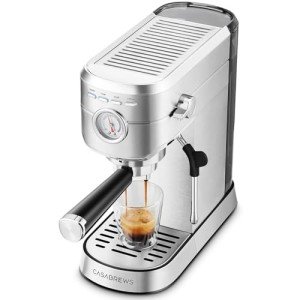Five Tools Everybody Within The High-Quality Espresso Machines Industry Should Be Using

The World of High-Quality Espresso Machines: A Comprehensive Guide
Espresso has actually ended up being a cherished drink amongst coffee enthusiasts worldwide, known for its abundant flavor, extreme fragrance, and adaptability. The heart of an excellent espresso lies in the machine utilized to brew it. High-quality espresso machines are developed to deliver the ideal shot, making them an essential investment for coffee enthusiasts. This post checks out different kinds of high-quality espresso machines, their features, maintenance suggestions, and responses to frequently asked concerns.
Kinds Of High-Quality Espresso Machines
High-quality espresso machines fall into numerous categories, catering to different preferences, skill levels, and budgets. The main types consist of:
| Type of Machine | Description | Perfect User |
|---|---|---|
| Manual Espresso Machines | Requires user ability to manage extraction and pressure. Offers the most control over the developing process. | Experienced baristas and enthusiasts |
| Semi-Automatic Machines | Integrates manual operation with automation. Users manage the grind and tamping, while the machine manages water dispersion. | Intermediate users |
| Automatic Espresso Machines | Automate the brewing process, enabling programmable brewing times and temperature levels. | Casual coffee drinkers |
| Super-Automatic Machines | Have built-in grinders and are totally automated, managing whatever from grinding to brewing and steaming. | Users seeking convenience |
| Commercial Espresso Machines | Designed for high volume use in cafes and dining establishments, using toughness and speed. | Entrepreneur |
Comprehensive Overview of Each Type
Manual Espresso Machines
- Pros: Complete control over the developing procedure; can produce exceptional quality espresso.
- Cons: Requires significant ability; time-consuming.
Semi-Automatic Machines
- Pros: Balanced control, blending manual and automatic procedures; exceptional quality espresso is still attainable.
- Cons: Requires some understanding and experience to master.
Automatic Espresso Machines
- Pros: User-friendly; reduces the learning curve while still producing high-quality espresso.
- Cons: Still requires some understanding of coffee-making basics.
Super-Automatic Machines
- Pros: Maximal benefit; little ability required; perfect for people or families who desire coffee without fuss.
- Cons: Higher cost point; might lack the fine-tuning abilities of manual machines.
Commercial Espresso Machines
- Pros: Built for durability and efficiency; typically consists of features for high-volume turns.
- Cons: Expensive; may be overkill for home use.
Secret Features to Consider
When looking for a high-quality espresso machine, several key features should be considered:
- Pressure and Pump Type: Look for machines with a minimum of 9 bars of pressure, which is essential for drawing out the very best flavor from coffee beans.
- Boiler Type: Single, double, and heat exchanger boilers each affect how the machine performs and the speed of brewing.
- Build Quality: High-quality materials such as stainless steel are preferable for resilience and aesthetics.
- Relieve of Use and Cleaning: Some machines require extensive cleaning, while others are developed for easy maintenance.
- Temperature level Control: Consistent temperature is vital; consider machines with PID controllers for precise control.
Benefits of High-Quality Espresso Machines
Purchasing a high-quality espresso machine provides a multitude of advantages:
- Superior Quality: High-end machines permit greater control, resulting in more delicious espresso.
- Durability: Built to last, quality machines require less repairs and replacements.
- Modification: Users can take pleasure in a customized experience by changing grind size, shot timing, and other settings.
- Increased Convenience: Automatic and super-automatic options enable connoisseurs to enjoy espresso with minimal effort.
Upkeep and Care for High-Quality Espresso Machines
To keep an espresso machine operating optimally, regular maintenance is important. Here are ideas for preserving a high-quality espresso machine:
Descale Regularly:
- Use a descaling option every few months to avoid accumulation of minerals from water, which can impact taste and efficiency.
Tidy the Brew Group:
- For machines with a removable brew group, tidy it regularly to guarantee a tidy extraction.
Change Water Filters:
- Use a water filter and change it as needed to decrease impurities in your developing water.
Daily Cleanings:
- Rinse the portafilter and group head after each use to prevent oil accumulation.
Watch on the Parts:
- Monitor seals, gaskets, and other parts for wear and tear and replace them as essential.
Often Asked Questions (FAQs)
1. What is the best espresso machine for novices?
For novices, a semi-automatic machine typically provides a good balance of functionality and control, enabling users to learn the skills required for making great espresso.
2. Are super-automatic machines worth the investment?
Yes, for those who prioritize convenience and ease over control, super-automatic machines can be a worthy financial investment, particularly for households or busy specialists.
3. Just how much should I expect to spend on a high-quality espresso machine?
High-quality espresso machines range significantly in rate, with manual machines starting at a couple of hundred dollars, while super-automatic or commercial machines can go beyond numerous thousand.
4. Can I make other coffee beverages with an espresso machine?
Yes, numerous espresso machines have steam wands or attachments that permit users to develop lattes, cappuccinos, and more.
5. How long do espresso machines normally last?
With correct maintenance, high-quality espresso machines can last over a years, making them a long-lasting investment in your coffee pleasure.
High-quality espresso machines yield a transformative coffee experience, whether delighted in at home or in a commercial setting. By understanding the types offered, their functions, and the upkeep needed to keep them running efficiently, customers can make informed decisions that raise their coffee-drinking experience.

